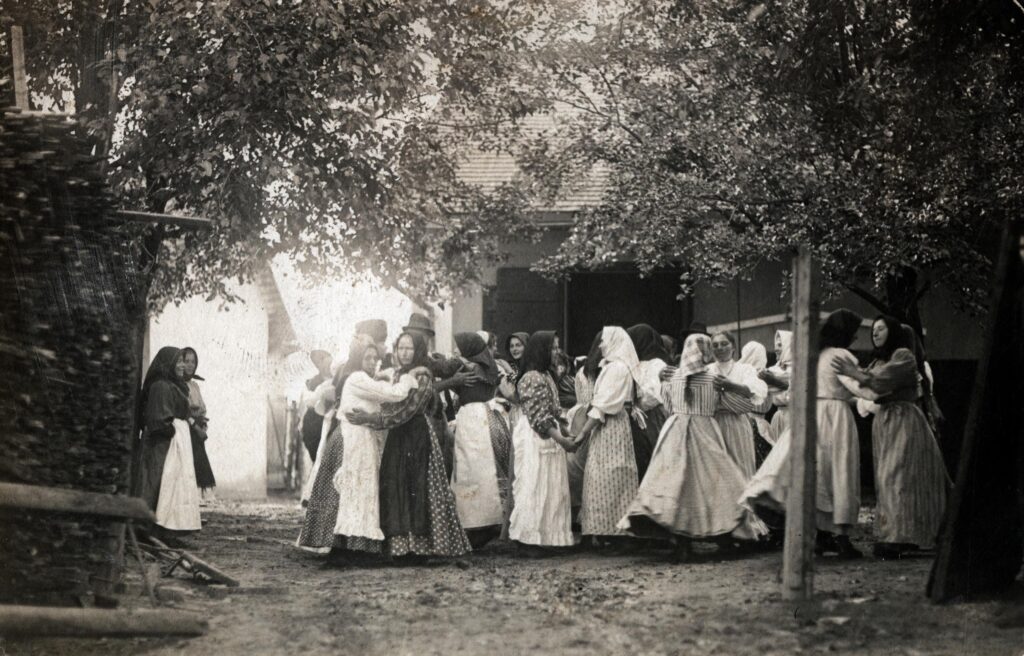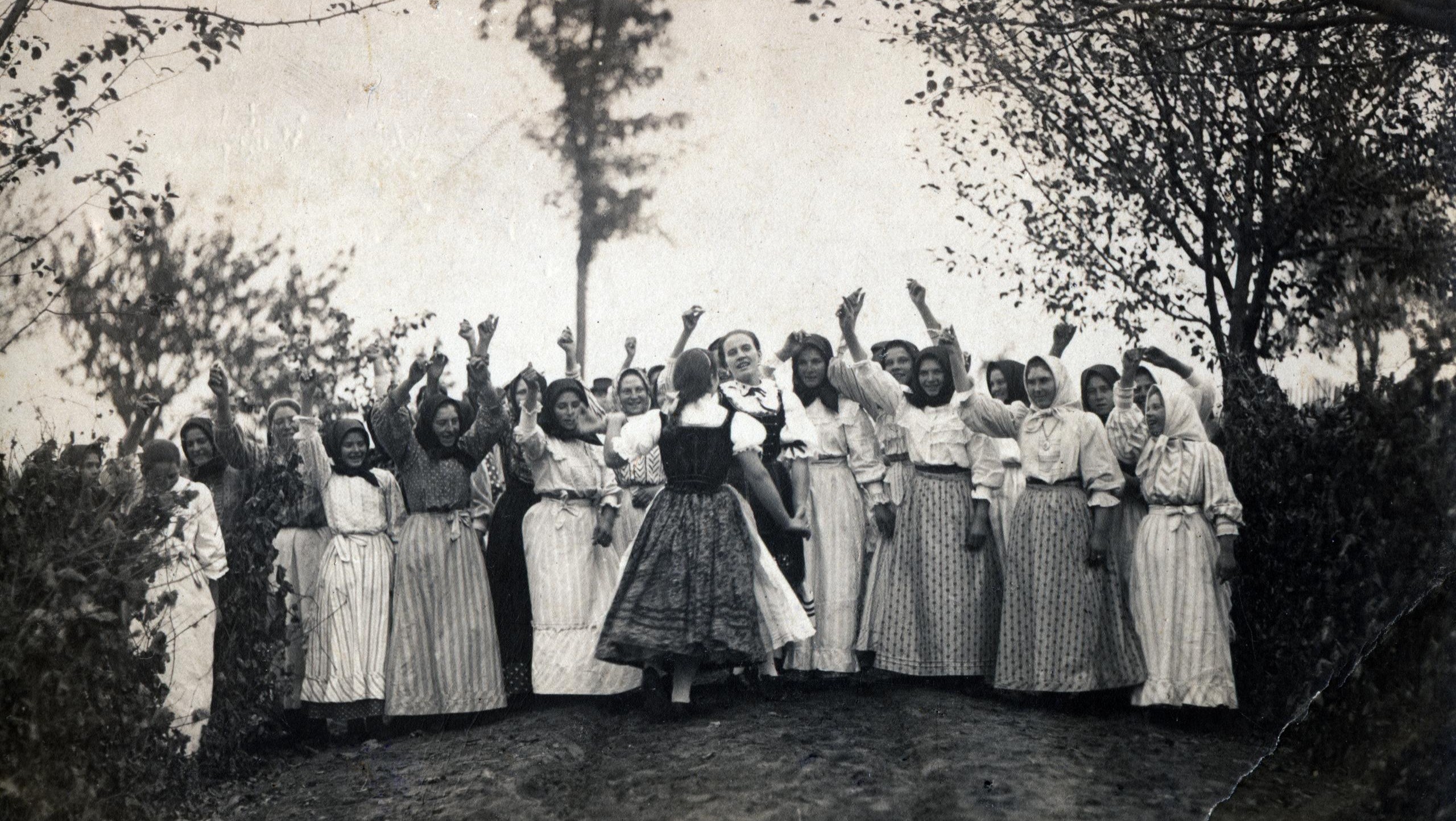The following is an adapted version of an article written by Orsolya Ferenczi-Bónis, originally published in Magyar Krónika.
First recorded in the 15th century, this special merrymaking for married women lasted until the second half of the 20th century, even though there were times when it was put to an end by a horde of demons. The only male participant was a hired musician, who provided the women with entertainment.
The most extravagant festivities of the carnival period, which lasted from Epiphany to Ash Wednesday, were concentrated on the last days of the carnival—it was also the time of the so-called Women’s Carnival. As the name suggests, only married women were allowed to take part in this special celebration, but some places held a girls’ Sunday as well when the girls would go through the village houses to greet the housewives with songs and to collect donations, then end the day with dancing.
Freedom from Restrictions
From ethnographer Tekla Dömötör’s work Magyar népszokások (Hungarian Folk Customs), we can learn that the merriment of married women consisted of a group masked parade in the morning, followed by a nightlong private drinking party and women’s ball, held in the house, cellar, or spinning room of one of the women, or perhaps in a tavern. The only male participant was a hired musician, who provided the women with entertainment.
For the women, it was a special occasion: a break from their strictly fixed lives to enjoy themselves. They drank beer and pálinka (Editor’s note: a traditional fruit spirit with origins in medieval Hungary), had fun, danced, swore, and sang obscene songs—all things that were outside the norm of behaviour that was typically expected of women in the closed community of villages.
‘For the women, it was a special occasion: a break from their strictly fixed lives to enjoy themselves’
The tradition of Women’s Carnival existed all over Europe, especially in Slavic and German folklore. In the Hungarian Encyclopaedia of Ethnography, we can read that the first records of Hungarian carnival as a folk custom date back to the 15th century, when Franciscan monk Pelbárt Temesvári first wrote about the carnival celebrations of the women of the Transdanubian villages—rather disapprovingly. The writer painted a greatly discouraging picture of Hungarian carnival customs as a whole, writing the following about the carnival days in his sermon on Shrove Sunday:
‘Alas, how many Christian people these days turn from the light of grace to the deeds of darkness, that is, to gluttony, drunkenness, and debauchery. Such people choose the devil as their god at the carnival, whom they glorify with masked revelry and lewd songs, despising Christ…There is not a day in the whole year when the devil takes so many people and drives them into his slavery with the yoke of sin as in these days when people spend their time in drunkenness, dancing, and lewdness…’
When the Devil Put an End to Women’s Carnival
Pelbárt Temesvári recalled the custom of the Women’s Carnival with a particularly cautionary tale. The events took place around 1480 in a village near Kapos. The young women gathered in one of their houses, wearing various masks and costumes, including men’s, playing masquerade games and dancing. The main organizer of the party, who encouraged the others to join in, danced with her companions until the devil took her. The devil, moreover, appeared in the form of an invisible demon, so that the others did not even know where she had been taken.
When the young woman disappeared from the dancers’ circle, the others searched the whole house for her, but as they couldn’t find her, they also started looking for her outside the village. By this time, the men from the village and other women had joined them, too. Soon, they began to hear voices, long, mournful, wailing cries coming from the marshes of Kapos. They were all startled at the noise, but as it was late at night, after dark, no one dared to sail into the marshes to see what was happening or to help the woman who had been dragged away.

The terrible screams continued, and the whole village was speculating about what to do, when finally, a brave man, the woman’s brother-in-law, got into a boat to save his sister-in-law. However, just as he had got a considerable distance from the shore, suddenly there was such a violent whirlwind and storm in the air and on the water that the boat began to roll wildly. The man could only observe that there was a whole horde of demons in the marsh when he was forced to turn back towards the shore, otherwise, he would have been swept into the water. The terrified villagers listened to the woman’s wailing from the middle of the swamp for a while longer, but when all sound had died away, they concluded that the woman herself must have died as well.
Men’s Shaving in Mátraalmás
Fortunately, not every carnival ended so horribly, and the custom was still alive in the second half of the 20th century. According to Tekla Dömötör, it survived longest in the villages on the northern slopes of the Mátra Mountains, mainly inhabited by Slovaks and Moravians. The Women’s Carnival in Mátraalmás is particularly well documented. These records also mention a special custom of shaving the men of the community in jest as part of the day-long festivities.
The official website of Mátraalmás recites that a group of dressed-up women went around the village singing, joking, and shouting, while the men ran away from them, some even trying to lock themselves in and some climbing up the haystacks. The women tried to catch as many of the escapers as possible, and those they caught were shaved with a wooden razor, then flour was thrown in their faces and a sieve with a hole in it was held up in front of them so that they could admire, as in a mirror, how well the women had done their work. Of course, the carnival day in Mátraalmás also ended with a private party, in which only one man—the accordionist—was allowed to take part.
‘The mass deportations of 1946–47, as part of the Hungarian–Czechoslovak population exchange agreement, played a huge role in the gradual disappearance of the villages’ traditions’
On the page, it is also written that the last time a women’s carnival was held in the village was in 1967, since the mass deportations of 1946–47, as part of the Hungarian–Czechoslovak population exchange agreement, played a huge role in the gradual disappearance of the villages’ traditions. ‘As a result of the large-scale, sudden loss of population, many families were split up, and the closed community formed by the village population was broken up. The gradual change in the local way of life imposed by the principles and measures of the socialist system, and the decline in the importance of traditional forms of livelihood, also contributed to the decline of local traditions,’ the website says.
Related articles:
Click here to read the original article.







